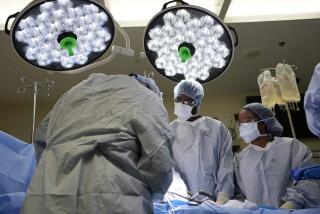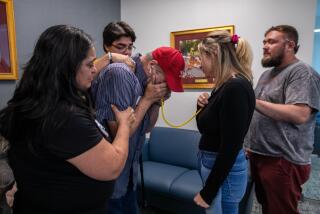New Tactic May Ease Transplants of Bone Marrow
- Share via
A novel technique for performing bone marrow transplants could allow virtually any family member of a leukemia patient to serve as a donor, a prospect that could eliminate the need for the tearful televised pleas for donors that have become common in recent years, researchers said Wednesday.
Using seven to 10 times the normal amount of donor marrow enables scientists to overwhelm the recipient’s immune system, allowing a much less precise immunological match than is required now, Italian and Israeli researchers report in the journal Blood.
Bone marrow transplants are a treatment of last resort for victims of leukemia and breast cancer and are slowly growing in importance as a therapy for as many as 60 genetic disorders, including thalassemia and sickle cell disease.
About 5,000 people receive bone marrow transplants each year--the vast majority for leukemia--but 5,000 to 15,000 die after they are denied them because of a lack of matching donors, according to the National Institutes of Health.
The team, led by biophysicist Yair Reisner of the Weizmann Institute in Rehovot, Israel, and Dr. Massimo F. Martelli of the Polyclinico Monteluce in Perugia, Italy, has treated 35 Italian patients and is continuing to accept at least one per week.
At least three medical centers in the United States are planning trials soon, including Childrens Hospital Los Angeles.
“This is a rather exciting and simple technological advance that, if it proves out in other centers, will greatly increase the scope of successful bone marrow transplants,” said Dr. John Laszlo, vice president for research at the American Cancer Society.
“We’re cautiously excited,” added Reisner. “We still have to prove it with more patients, but it looks very good so far.”
The bone marrow transplant is not itself therapeutic--it does not kill cancer cells. That is achieved with very high doses of radiation and chemotherapy, which are used in an attempt to wipe out the last vestiges of cancer cells in leukemia patients who have not improved with lower doses of chemotherapy.
But these high doses also kill the healthy bone marrow.
Bone marrow is the source of all blood cells, both white and red. Without it, a patient normally dies within a few days. A transplant gives the patient a new immune system.
But good results require an exact match at the eight histocompatibility sites on the cell, called loci, that are used by immunologists to determine tissue compatibility.
About 30% of leukemia patients have a brother or sister who is an exact match and 3% to 5% have another relative who is such a match. In such cases, about 90% of the grafts are successful.
If a relative is not available, a donor is sought among unrelated individuals. On average, about one person in every 20,000 will provide an immunological match for any patient at five or six of the loci.
Since 1987, there have been about 2,900 transplants using unrelated donors, according to the International Bone Marrow Transplant Registry. The overall success rate for these patients ranges between 30% and 40%, depending on the stage of their disease.
Reisner has been working on rodents for 10 years trying to find a way to circumvent the need for precisely matched donors. He concluded that the primary reason for rejection of an unmatched marrow graft is residual white cells from the patient’s immune system, which prevent survival of the graft.
Reisner’s studies in mice showed that using “megadoses” of donor marrow could overcome this problem, allowing the graft to survive.
These megadoses are much greater than the amount of marrow that can be obtained from the bone in an arm or leg, the usual site of a donation. To obtain the necessary quantities for use in humans, Martelli adapted a technique that is used to preserve bone marrow in breast cancer patients who receive high doses of chemotherapy or radiation.
He injects a hormone into the donor to stimulate the production of stem cells, which are the precursors of all blood cells, and to trigger their release into the bloodstream, then harvests them from the blood. This process produces as much as 10 times the amount of marrow otherwise obtained.
Martelli’s team began testing the technique early last year at the hospital in Perugia, and results with the first 17 patients are discussed in today’s report. All of the patients had either acute myelocytic leukemia or acute lymphocytic leukemia and all were considered terminal. “These patients were really, really sick, with a life expectancy of weeks or even days,” Martelli said.
Each received a transplant from a parent or sibling that was mismatched at three of the eight loci. The graft survived in 16 of the 17 patients. Only two of the patients died from their leukemia, but six died of respiratory infections, one from a fungus infection and one from graft-versus-host disease. Six are still alive, the longest for 21 months.
Although that survival rate seems small, Martelli said, it is about the same as was achieved 20 years ago in the first experimental bone marrow transplants using precisely matched donors. As they did then, however, physicians are learning how to control the infections and other problems that developed in the first grafts, and the survival rate is increasing. Among 18 patients treated since Martelli’s initial group, only about 30% have died.
American researchers are eager to try the technique, and oncologists at M.D. Anderson Hospital in Houston and Children’s Hospital in St. Petersburg, Fla., as well as in Los Angeles, are getting ready to recruit their first patients.
“What was impressive and exciting was their ability to get this mismatched bone marrow to work and grow in the recipients without the usual fatal complications that you would see in such a transplant,” said Dr. Carl Lenarsky, director of the bone marrow transplant program at Childrens Hospital Los Angeles. “We are encouraged by it, and have decided that we will undertake this approach.”
Marrow ‘Megadoses’
A new technique using large doses of bone marrow for transplants promises to eliminate the need for precise immunological matching, making much larger numbers of donors available for victims of leukemia and certain genetic diseases.
1) A hormone is injected into a donor to stimulate production of stem cells, the crucial cells in bone marrow.
2) Five days later, blood is drained from the arm and centrifuged to remove stem and other white cells. Red cells and other blood components are reinfused into the donor.
3) The stem cells are treated to remove undesirable white cells and injected into the patient.
Source: Los Angeles Times






